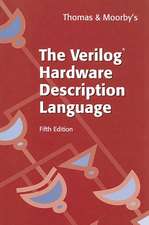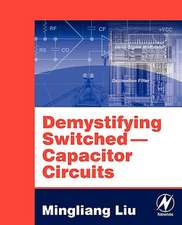CMOS Circuits for Piezoelectric Energy Harvesters: Efficient Power Extraction, Interface Modeling and Loss Analysis: Springer Series in Advanced Microelectronics, cartea 38
Autor Thorsten Hehn, Yiannos Manolien Limba Engleză Paperback – 23 aug 2016
Due to these key properties enabling universal usage, other CMOS designers working in the field of energy harvesting will be encouraged to use some of the shown structures for their own implementations. The book is unique in the sense that it highlights the design process from scratch to the final chip. Hence, it gives the designer a comprehensive guide of how to (i) setup an appropriate harvester model to get realistic simulation results, (ii) design the integrated circuits for low power operation, (iii) setup a laboratory measurement environment in order to extensively characterize the chip in combination with the real harvester and finally, (iv) interpret the simulation/measurement results in order to improve the chip performance. Since the dimensions of all devices (transistors, resistors etc.) are given, readers and other designers can easily re-use the presented circuit concepts.
| Toate formatele și edițiile | Preț | Express |
|---|---|---|
| Paperback (1) | 636.80 lei 6-8 săpt. | |
| SPRINGER NETHERLANDS – 23 aug 2016 | 636.80 lei 6-8 săpt. | |
| Hardback (1) | 643.00 lei 6-8 săpt. | |
| SPRINGER NETHERLANDS – 14 aug 2014 | 643.00 lei 6-8 săpt. |
Din seria Springer Series in Advanced Microelectronics
- 15%
 Preț: 645.79 lei
Preț: 645.79 lei - 24%
 Preț: 1571.35 lei
Preț: 1571.35 lei - 18%
 Preț: 951.59 lei
Preț: 951.59 lei - 20%
 Preț: 645.31 lei
Preț: 645.31 lei - 15%
 Preț: 643.34 lei
Preț: 643.34 lei - 18%
 Preț: 1007.35 lei
Preț: 1007.35 lei - 18%
 Preț: 1229.38 lei
Preț: 1229.38 lei - 15%
 Preț: 641.03 lei
Preț: 641.03 lei - 18%
 Preț: 954.45 lei
Preț: 954.45 lei - 15%
 Preț: 641.20 lei
Preț: 641.20 lei - 18%
 Preț: 1842.94 lei
Preț: 1842.94 lei - 15%
 Preț: 639.84 lei
Preț: 639.84 lei - 18%
 Preț: 1051.98 lei
Preț: 1051.98 lei - 18%
 Preț: 955.70 lei
Preț: 955.70 lei - 18%
 Preț: 953.82 lei
Preț: 953.82 lei - 15%
 Preț: 638.24 lei
Preț: 638.24 lei - 18%
 Preț: 1110.55 lei
Preț: 1110.55 lei -
 Preț: 387.20 lei
Preț: 387.20 lei - 15%
 Preț: 642.68 lei
Preț: 642.68 lei - 18%
 Preț: 956.81 lei
Preț: 956.81 lei - 15%
 Preț: 642.03 lei
Preț: 642.03 lei - 18%
 Preț: 947.35 lei
Preț: 947.35 lei - 18%
 Preț: 955.88 lei
Preț: 955.88 lei - 15%
 Preț: 632.70 lei
Preț: 632.70 lei - 18%
 Preț: 936.95 lei
Preț: 936.95 lei - 18%
 Preț: 946.87 lei
Preț: 946.87 lei - 18%
 Preț: 1559.80 lei
Preț: 1559.80 lei - 15%
 Preț: 638.43 lei
Preț: 638.43 lei
Preț: 636.80 lei
Preț vechi: 749.19 lei
-15% Nou
Puncte Express: 955
Preț estimativ în valută:
121.87€ • 126.76$ • 100.61£
121.87€ • 126.76$ • 100.61£
Carte tipărită la comandă
Livrare economică 15-29 aprilie
Preluare comenzi: 021 569.72.76
Specificații
ISBN-13: 9789402403541
ISBN-10: 940240354X
Pagini: 221
Ilustrații: XVII, 204 p. 137 illus.
Dimensiuni: 155 x 235 x 12 mm
Greutate: 0.32 kg
Ediția:Softcover reprint of the original 1st ed. 2015
Editura: SPRINGER NETHERLANDS
Colecția Springer
Seria Springer Series in Advanced Microelectronics
Locul publicării:Dordrecht, Netherlands
ISBN-10: 940240354X
Pagini: 221
Ilustrații: XVII, 204 p. 137 illus.
Dimensiuni: 155 x 235 x 12 mm
Greutate: 0.32 kg
Ediția:Softcover reprint of the original 1st ed. 2015
Editura: SPRINGER NETHERLANDS
Colecția Springer
Seria Springer Series in Advanced Microelectronics
Locul publicării:Dordrecht, Netherlands
Cuprins
1 Introduction.- 2 Piezoelectricity and Energy Harvester Modelling.- 3 Analysis of Different Interface Circuits.- 4 Theory of the Proposed PSCE Circuit.- 5 Implementation of the PSCE Circuit on Transistor Level.- 6 Performance Analysis of the PSCE Chip.- 7 Conclusions and Outlook. References.- Appendix A Mathematical Calculations.- A.1 Solution of the Linear Differential Equation Systems.- A.2 Flux Property.- A.3 Trigonometric Relations.- A.4 Numerical Calculation.
Notă biografică
Thorsten Hehn received the Dipl.-Ing. degree in Microsystems Engineering from the University of Freiburg in 2006 and the Dr.-Ing. Degree in Microsystems Engineering from the University of Freiburg in 2014.
Dr. Hehn started his research activity in Energy Harvesting in 2006 during his diploma thesis, which was on an energy harvesting based sensor system exclusively supplied by a vibration based inductive energy harvester. After finishing his studies, he joined the graduate program “Micro Energy Harvesting”, funded by the Deutsche Forschungsgemeinschaft (DFG), where he worked on highly efficient energy extraction from piezoelectric energy harvesters. For this purpose, he implemented switched schemes in low power CMOS integrated circuits, increasing the power which can be extracted from the harvester compared to standard full bridge rectifiers. He also investigated methods of modelling the mechanical harvester structure, which is essential for electrical simulations.
After his time in the graduate program, Dr. Hehn worked on the BMBF project “ASYMOF” on the evaluation and development of an energy autonomous anti-theft alarm system for automobiles. In this project, he developed a wireless sensor node exclusively powered by thermoelectric energy harvesting.
In 2012, Dr. Hehn joined the Institute of Micromachining and Information Technology (HSG-IMIT) as a scientific researcher. Since then, he has developed an education kit for academia, demonstrating the resonance characteristics of vibration based inductive energy harvesters and the influence of different power management components on the output voltage of the harvester. In addition, he has contributed several power management components for gyroscope based sensor readout ASICs.
Yiannos Manoli is the Dean of Engineering and holds the Fritz Huettinger Chair of Microelectronics in the Department of Microsystems Engineering (IMTEK) at the University of Freiburg,Germany. Since 2005 he has additionally served as director of the applied research “Institute of Micromachining and Information Technology” of the “Hahn-Schickard Gesellschaft” (HSG-IMIT). His research interests are the design of low-voltage and low-power mixed-signal systems with over 300 papers published in these areas. The emphasis lies in Analog-to-Digital converters as well as in energy harvesting and sensor read-out CMOS circuits. Additional research activities concentrate on motion and vibration energy transducers and on inertial sensors.
Prof. Manoli received Best Paper Awards from ESSCIRC 2012, 2009 and 1988, MWSCAS 2007, MSE 2007 and Power MEMS 2006. For his creative and effective contributions to the teaching of microelectronics and the design of a web-based animation and visualization of analog circuits (Spicy VOLTsim) he received various awards including the Excellence in Teaching Award of the University of Freiburg and the Teaching Award of the State of Baden-Württemberg.
Prof. Manoli served as a Distinguished Lecturer of the IEEE, as well as Guest Editor of the “IEEE Transactions on VLSI Systems” and the “IEEE Journal of Solid-State Circuits”. He is on the Senior Editorial Board of the IEEE “Journal on Emerging and Selected Topics in Circuits and Systems” and on the Editorial Board of the “Journal of Low Power Electronics”. Professor Manoli has served on the committees of a number of conferences such as ISSCC, ESSCIRC, IEDM and ICCD and was Program Chair (2001) and General Chair (2002) of the IEEE International Conference on Computer Design (ICCD).
He holds a B.A. degree (summa cum laude) in Physics and Mathematics, a M.S. degree in Electrical Engineering and Computer Science from the University of California, Berkeley and the Dr.-Ing. degree in Electrical Engineering from the Gerhard Mercator University in Duisburg, Germany.
Dr. Hehn started his research activity in Energy Harvesting in 2006 during his diploma thesis, which was on an energy harvesting based sensor system exclusively supplied by a vibration based inductive energy harvester. After finishing his studies, he joined the graduate program “Micro Energy Harvesting”, funded by the Deutsche Forschungsgemeinschaft (DFG), where he worked on highly efficient energy extraction from piezoelectric energy harvesters. For this purpose, he implemented switched schemes in low power CMOS integrated circuits, increasing the power which can be extracted from the harvester compared to standard full bridge rectifiers. He also investigated methods of modelling the mechanical harvester structure, which is essential for electrical simulations.
After his time in the graduate program, Dr. Hehn worked on the BMBF project “ASYMOF” on the evaluation and development of an energy autonomous anti-theft alarm system for automobiles. In this project, he developed a wireless sensor node exclusively powered by thermoelectric energy harvesting.
In 2012, Dr. Hehn joined the Institute of Micromachining and Information Technology (HSG-IMIT) as a scientific researcher. Since then, he has developed an education kit for academia, demonstrating the resonance characteristics of vibration based inductive energy harvesters and the influence of different power management components on the output voltage of the harvester. In addition, he has contributed several power management components for gyroscope based sensor readout ASICs.
Yiannos Manoli is the Dean of Engineering and holds the Fritz Huettinger Chair of Microelectronics in the Department of Microsystems Engineering (IMTEK) at the University of Freiburg,Germany. Since 2005 he has additionally served as director of the applied research “Institute of Micromachining and Information Technology” of the “Hahn-Schickard Gesellschaft” (HSG-IMIT). His research interests are the design of low-voltage and low-power mixed-signal systems with over 300 papers published in these areas. The emphasis lies in Analog-to-Digital converters as well as in energy harvesting and sensor read-out CMOS circuits. Additional research activities concentrate on motion and vibration energy transducers and on inertial sensors.
Prof. Manoli received Best Paper Awards from ESSCIRC 2012, 2009 and 1988, MWSCAS 2007, MSE 2007 and Power MEMS 2006. For his creative and effective contributions to the teaching of microelectronics and the design of a web-based animation and visualization of analog circuits (Spicy VOLTsim) he received various awards including the Excellence in Teaching Award of the University of Freiburg and the Teaching Award of the State of Baden-Württemberg.
Prof. Manoli served as a Distinguished Lecturer of the IEEE, as well as Guest Editor of the “IEEE Transactions on VLSI Systems” and the “IEEE Journal of Solid-State Circuits”. He is on the Senior Editorial Board of the IEEE “Journal on Emerging and Selected Topics in Circuits and Systems” and on the Editorial Board of the “Journal of Low Power Electronics”. Professor Manoli has served on the committees of a number of conferences such as ISSCC, ESSCIRC, IEDM and ICCD and was Program Chair (2001) and General Chair (2002) of the IEEE International Conference on Computer Design (ICCD).
He holds a B.A. degree (summa cum laude) in Physics and Mathematics, a M.S. degree in Electrical Engineering and Computer Science from the University of California, Berkeley and the Dr.-Ing. degree in Electrical Engineering from the Gerhard Mercator University in Duisburg, Germany.
Textul de pe ultima copertă
This book deals with the challenge of exploiting ambient vibrational energy which can be used to power small and low-power electronic devices, e.g. wireless sensor nodes. Generally, particularly for low voltage amplitudes, low-loss rectification is required to achieve high conversion efficiency. In the special case of piezoelectric energy harvesting, pulsed charge extraction has the potential to extract more power compared to a single rectifier. For this purpose, a fully autonomous CMOS integrated interface circuit for piezoelectric generators which fulfills these requirements is presented.
Due to these key properties enabling universal usage, other CMOS designers working in the field of energy harvesting will be encouraged to use some of the shown structures for their own implementations. The book is unique in the sense that it highlights the design process from scratch to the final chip. Hence, it gives the designer a comprehensive guide of how to (i) setup an appropriate harvester model to get realistic simulation results, (ii) design the integrated circuits for low power operation, (iii) setup a laboratory measurement environment in order to extensively characterize the chip in combination with the real harvester, and finally, (iv) interpret the simulation/measurement results in order to improve the chip performance. Since the dimensions of all devices (transistors, resistors etc.) are given, readers and other designers can easily re-use the presented circuit concepts.
Due to these key properties enabling universal usage, other CMOS designers working in the field of energy harvesting will be encouraged to use some of the shown structures for their own implementations. The book is unique in the sense that it highlights the design process from scratch to the final chip. Hence, it gives the designer a comprehensive guide of how to (i) setup an appropriate harvester model to get realistic simulation results, (ii) design the integrated circuits for low power operation, (iii) setup a laboratory measurement environment in order to extensively characterize the chip in combination with the real harvester, and finally, (iv) interpret the simulation/measurement results in order to improve the chip performance. Since the dimensions of all devices (transistors, resistors etc.) are given, readers and other designers can easily re-use the presented circuit concepts.
Caracteristici
Includes a guide of how to extract model parameters for given piezoelectric harvester Helps integrated circuit designers to develop their own chips for energy harvesters Presented circuit concepts can be re-used since dimensions of all devices are given Detailed theoretical and analytical analysis of chip losses helps achieving high efficiency Gives hints of how to characterize the fabricated chip in combination with the real harvester Includes supplementary material: sn.pub/extras












